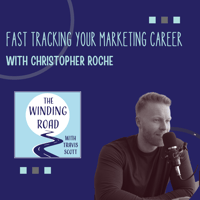Inbound vs Outbound Marketing and Your Career
I’m currently reading From Impossible to Inevitable by Aaron Ross and Jason Lemkin. You might think it’s strange that a marketing person is reading a book about sales. Prior to marketing, I was in sales roles. Both legit sales roles and recruiting, which is mostly a sales role.
If great marketers make change, they also are connecting buyers with sellers. Buyers don’t always have to be physically purchasing something. It could also mean creating buy-in to a concept, idea, or in the case of your career, buying into your skills and experience.
Great marketing bookends the sales process. It creates awareness before the sale and it helps in maintaining a great customer experience after the sale. To be a great marketer, it’s important to understand sales.
It’s a great book that aligns perfectly with a lot of the same principles I adhere to in marketing. Mostly, having a deep understanding of what your product or service is for, who it’s for, and who it’s not for and only focusing on the minimal viable market at first and growing it from there.
The book mostly talks about outbound sales efforts but mentions the importance of pairing this with inbound strategies.
I’ll now get into what inbound and outbound mean and how they are applicable to our career.
For just about any business, sales are what keeps them alive and enables them to grow. Getting the attention of and engaging with potential customers is at the heart of all of sales.
In a B2B (business-to-business) setting, there are common workflows. A lead comes in, it’s passed to sales, and that’s where a lead turns into a customer. If it’s a smart company, they’ll continue to engage that customer, ensure their success with the products or services, and build a lasting relationship.
Sometimes, the sales cycle can be long. What I mean by this, is it could take months from the time a lead shows interest in your product or service to the time they become a customer.
There are often multiple people involved in the buying decision, unlike B2C (business-to-consumer) where one person (usually) is in charge of the purchase decision and it can be made in a matter of minutes. Think about how you shop on Amazon.
You may be asking, ‘why are you telling me all of this?’ And that’s a great question. There’s a point.
The point is, the relationships we develop throughout our careers operate in a similar way.
Trust me on this and try to stay with me. It will all make sense in the end.
Businesses obtain leads in one of two ways: inbound and outbound efforts.
Inbound means the leads come to you. Outbound means you go to them.
Inbound can be viewed as a large fishing net. It’s cast fairly wide and will bring in a lot of different types of people or leads. Some won’t be leads at all and are tossed back into the ocean. Others are a great fit and will be passed along to sales to continue with the next steps of educating and relationship building.
Outbound is like fishing with a spear. It’s very targeted. You know exactly the type of ‘fish’ you’re looking for and, although you don’t bring back a lot of fish (leads) the ones you end up with are high quality with a high likelihood of closing. When you fish with a spear, you’re also going to miss from time to time. That’s OK. That fish wasn’t for you.
Early on, you might miss more than you hit. That’s OK. Each time you miss, your aim gets a little better, more refined.
Examples of inbound methods include blog posts, social media posts, and ads.
Outbound examples include sending 1-to-1 emails and making phone calls. Cold emails and phone calls. But, in today’s world, it’s mostly email.
Throughout our careers, we should always be doing a little bit of both. Even when we’re not looking for another opportunity. It’s important to always be visible because it’s impossible to know of every opportunity that could present itself.
When you become active in searching for a new role, the outbound piece becomes more important. However, outbound is always easier if they know who you are or are familiar with you.
From a career perspective, here’s how you can look at things through an inbound and outbound lens.
Inbound for Your Career
Like a business would create content, you too should create content. If you can write, you should write. If you prefer talking, you should create a podcast. If you like to create short videos, create short videos. Or do all three. It could also be as simple as posting your thoughts or perspectives on a social media platform like LinkedIn or Twitter and actively engaging and encouraging engagement there.
If you’re an artist, find a way to get your art out into the world.
The bottom line, is you want to be visible. You never know who may find you and what doors could open - now or in the future.
Outbound for Your Career
Outbound as it relates to this scenario, your career, is focused narrowly on specific individuals. Take LinkedIn or Twitter for example. You would seek out people you want to connect with and either follow them on Twitter or send a connection request on LinkedIn.
If possible, you’ll want to add a personal note to each connection outreach. If it’s Twitter and the person is open to DM’s, you might send a DM introducing yourself after a week or so of following them. Let them know that you enjoy the content they share and their perspectives and that you’re looking forward to seeing more.
If it’s LinkedIn, be sure to include a 1-to-1, personalized message with each connection request. Let them know what you may have in common or what it was about their profile that caught your attention.
Once you make a connection then you can engage in a combination of inbound and outbound. Sharing your content (in hopes the algorithm or whatever platforms you’re on allows them to see it), engaging directly with their content and, if it makes sense, messaging them directly if it’s something you want to take ‘offline’ and not have seen in a public forum.
This concept is still a little rough and I’m not sure if I have been able to articulate this as clearly as it’s in my mind. This whole Daylight Saving Time thing has me a little messed up this morning.
Each of these concepts - both outbound and inbound - could stand alone in their own post and maybe then I’ll be able to more clearly articulate my thoughts on each.
-1.png?width=500&height=125&name=Website%20Logo%20-%20400x100%20(transparent%20background)-1.png)

